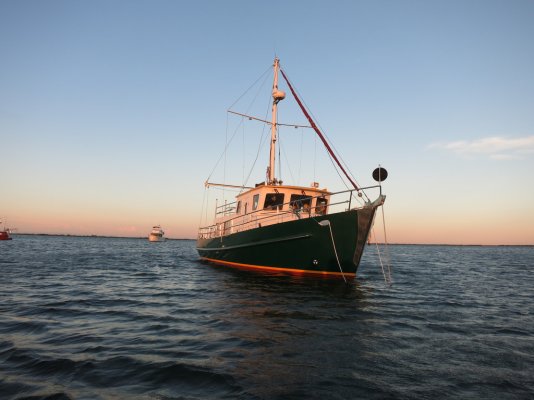O C Diver
Guru
- Joined
- Dec 16, 2010
- Messages
- 13,335
- Location
- Fort Myers, Florida
- Vessel Name
- End Of The Line
- Vessel Make
- Trinka 10 Dinghy
Tried to stay out of this, but just can’t resist. Let me start by saying this applies to the Bahamas, where we spend our winters. So, to all of those who think that letting the boat drift back to set the anchor will work in the Bahamas, please don’t anchor near me. As a gross generalization, the Bahamas has two types of bottoms, deep sand that will hold no matter how you anchor ( most of the Exumas) and thin sand over hard pack ( Black Point, most of Eleuthera, etc.)
We back down at 1000 rpm. What often happens in thin sand anchorages is the anchor will hold at 700 rpm, then pop out at 900 or so (55k Vulcan). I have gone in the water while my wife goes through the setting process. In thin sand the tip hooks on whatever, maybe 6” deep. Then when she backs down it pops out and drags. If we stick around and keep trying we sooner or later get a good set. Then we watch as the neighborhood goes to hell. Boats come in, use the “ let the wind set the anchor” routine, and start mixing their drinks. If they don’t threaten us, we pour a drink as well and get ready for the arrival of the squall that is sure to come.
When the wind picks up, equivalent pull to my 900 rpm backing down routine, the “ let the wind set my anchor” crowd wanders off towards the reefs. (If I may digress for a minute, this is classic Block Island entertainment as well)
So my comment to the “ let the wind set my anchor” skippers. If you have been getting away with this routine then you are lucky or anchor in an area where this works, maybe Chesapeake mud, but it is not a technique that will serve you well in the long run. You will never know if the anchor will hold in that next squall unless you try.
I have goon this far, so might as well comment on the scope issue. As to the Bahamas, once set I think 5:1 is plenty for anything less than a major front. I have dove on the anchor many times and at 7:1 and gusting 30 knots the chain never lifts off the sand for the last 20’ or so. Tells me I have more scope than I need. Same goes for Chesapeake mud. At 7:1, while retrieving the anchor after a wind reversal, it is apparent that the reversal never got to the anchor, in fact never got to the last 20’ of chain. So, for most conditions, 20 knots or less, my baseline is 5:1.
What our scope discussion is missing is wind and current conditions ( knowable facts) and the actual set conditions( often unknowable unless you can dive the anchor). So 3:1 may work well with 300’ of chain out in light winds and with the anchor embedded in the rocks, but will be totally ineffective in the Bahamas in 15’ of water and sand over hard pack. The challenge is knowing which is which. And if you can’t dive on the anchor, then plan for the worst.
If I get to an anchorage and 3:1 is all that will fit, I leave. If I get there first and have 5:1 because that’s what I feel I need to be able to sleep, I am not going to shorten scope to accommodate the next arrival.
And if the next arrival is a “drop the anchor and drift back” type, I leave. I probably shouldn’t hit send, but after a glass of wine, what the heck.
Two observations:
So I'm good everywhere on the East coast except part of the Bahamas and Block Island. I can live without that 1/1000 of 1% of East coast anchorages.
As mentioned previously, my boat sails at anchor. If I'm hooked on a ledge, it's likely going to come off fairly quickly.
On a more serious note, how do you know it won't find a ledge when it reverses? If the chain runs over the anchor on a reversal, they tend to come out as opposed to rotate in place.
Ted





